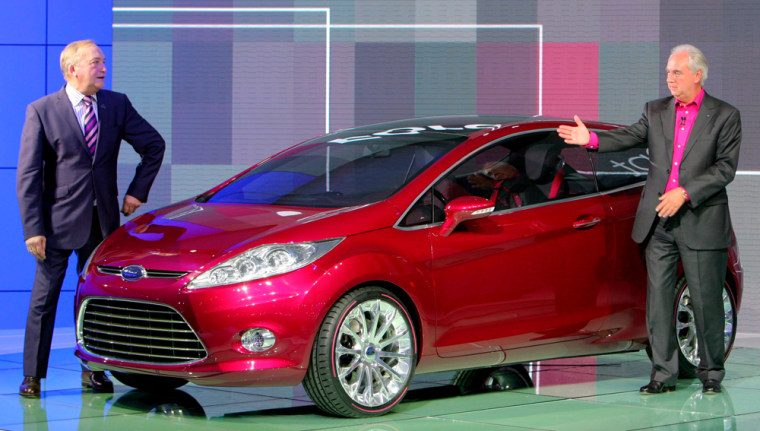Mention the Ford Fiesta to most Americans and they’ll likely think of the small car that sold here for a few years in the late 1970s as American car buyers, spurred by the oil crisis, warmed briefly to pocket-sized cars.
The Fiesta proved unsuitable for American consumers who have long preferred their cars a little larger, but overseas it was a smash hit. In the United Kingdom it has ranked among the top 10 most-sold cars since 1977 — a feat unmatched by any other car. Today it ranks as the country’s fifth overall best-selling vehicle.
Now the automaker hopes to bring some of that success back across the pond, announcing recently that the Fiesta will return to North America in 2010. It’s expected to look much like the stylish Verve concept compact car shown last month at the Detroit auto show and will make its debut at the Geneva auto show in March.
Ford is banking on projections for strong growth in the small car and car-based “crossover” vehicle segments, with the automaker saying U.S. small-car sales are expected to increase by more than 25 percent through 2012.
But the Fiesta looks set to miss out on some of that growth, points out Aaron Bragman, an auto industry analyst for the consulting company Global Insight.
The car goes on sale in Europe in the fall of this year, but it won’t be available for purchase in the United States until 2010. Ford has pledged to shake up its product line-up, which has been criticized for being too bland and lacking in new ideas, but a two-year wait for the new Fiesta won’t do, he said.
“The Fiesta is the best-looking small car Ford has ever produced, but the question is why it isn’t coming to the U.S. now?” said Bragman. “Maybe there’s a manpower issue, but you have to wonder if they’re really serious about improving their product development speed. They need that car here now and not in 2010.”
The introduction of the Fiesta is part of Ford’s plan to breathe new life into its core brand, relying on a global approach. The Fiesta will be a global car available worldwide, including Asia, Australia and the Americas.
It’s also part of Ford’s small-car vision for North America. The automaker hopes to take advantage of a projected strong growth in small car sales and appeal to “Millennials” or “Generation Y” — essentially, those born between 1980 and 1995 and the fastest-growing segment of the population — with sophisticated technology and expressive design.
“Ford has come to the conclusion, rightly or wrongly, that a premium small car can be successful in the United States,” said Jack Nerad, executive market analyst for Kelley Blue Book, which tracks the automotive industry.
“Up to now, the premise has been that as soon as consumers have the wherewithal they will move out of smaller vehicles and into bigger ones, and so the smallest cars have tended to be entry-level vehicles," he said.
The jury’s still out on whether a premium small car with more features, better styling and better handling can do well in the United States, Nerad added.
Ford may struggle to replicate the success of the Mini Cooper, the quintessential premium subcompact.
When the redesigned Mini Cooper and Cooper S was introduced into the U.S. market at the turn of the new century the American car-buying public had no preconceptions of the brand, and so the manufacturer was able to market the model successfully as a premium, stylish small car, said Nerad.
“There’s nothing especially wrong with the Ford brand, but it’s not one you would regard as premium, like Audi or perhaps Scion. Ford brings to mind big trucks and affordable transportation, so putting out something with the Ford brand in such a competitive segment has its difficulties,” he said.
Global Insight’s Bragman doesn’t expect the Fiesta to compete with upscale vehicles like the Mini, but rather with the entry-level newcomers like the Chevrolet Aveo, Honda Fit and Toyota Yaris — three recently introduced small cars that aim to benefit from a new interest in fuel economy.
“The bigger question now for the entry-level car segment is the broader economic situation,” Bragman said. “As the economy slows and the housing market downturn continues to bite, buyers are staying out of the market — that’s the big issue right now for the mass-market players.”
